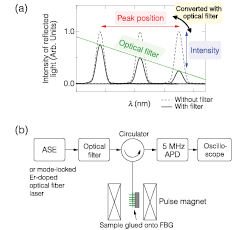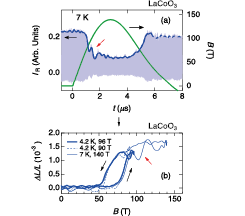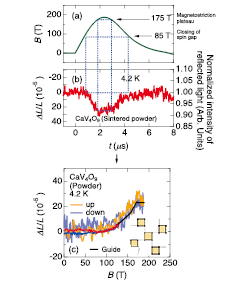Magnetostriction Measurements up to 190 T
Y. Matsuda and Kobayashi Groups
Magnetic field is a unique parameter that directly acts on the spin, orbital angular momentum and phases of wavefunction of electrons in solids. High magnetic field of 100 T roughly corresponds to 100 K in energy scale. Therefore, it is expected that novel state of matter emerges under high magnetic fields, besides being just a controlling parameter of matter. Researches using non-destructive pulsed magnetic fields has been greatly successful in the last several decades both in magnet technique and measurement techniques. On the other hand, despite the fact that the ultra-high magnetic fields well above 100 T have been available using destructive pulse magnets in ISSP since 1980s, the deepening of condensed matter physics using those destructive pulse magnets is still to come. It is due to the limited space and time of the generated ultrahigh magnetic fields that is making various solid state measurements difficult such as resistivity, magnetization and others.

Fig. 1. (a) Schematic drawing of optical filter method for FBG peak detection (b) Schematics of developed FBG and optical filter based magnetostriction measurement system.

Fig. 2. (a) FBG signal from LaCoO3 at 7 K up to 150 T whose pulse duration is 7 μs. (b) Magnetostriction of LaCoO3 at 7 K up to 150 T obtained from the above data.

Fig. 3. (a) FBG signal from CaV4O9 at 4.2 K up to 190 T (b) Generated pulsed magnetic field using single turn coil whose pulse duration is 7 μs. (c) Magnetostriction of CaV4O9 at 4.2 K up to 190 T obtained from the above data, showing the closing of spin gap and entering into a plateau region.
In the present study, we report the achievement of the measurement of magnetostriction which is one of the macroscopic measure that was impossible so far under ultrahigh magnetic fields above 100 T. Developed magnetostriction measurement system relies on fiber Bragg grating (FBG) technique. FBG is an optical fiber with which one is able to detect strain of matter by observing the Bragg wavelength in the reflection. In the present study, we employed the optical filter method where the information of the shift of the Bragg wavelength is converted to the intensity of the reflected light as shown in Fig. 1(a), which can be detected at high speed of 100 MHz. The high-speed of 100 MHz is indispensable for the measurement under ultrahigh magnetic field generated with destructive pulse magnet because the pulse duration is only a few micron seconds. As a light source, a mode-locked Er-doped optical fiber laser is utilized as shown in Fig. 1(b). This enables one to use the modulated measurement which is more robust against noises.
We have confirmed that we are able to measure magnetostriction of LaCoO3 up to 150 T as shown in Figs. 2(a) and 2(b) [1, 2], and CaV4O9 up to 190 T with the best resolution of 2.0 × 10-5 as shown in Figs. 3(a), 3(b) abd 3(c). Using the technique with the electromagnetic flux compression technique generating magnetic field of above 500 T is under way. Also, we have applied the developed FBG based strain measurement system to non-destructive pulse magnets, where we have been successful in measuring the magnetostriction of volborthite with the resolution of 1.0 × 10-6 [3]. The FBG based magnetostriction study under ultrahigh magnetic field for the valence fluctuation system, quantum spin system, spin-crossover systems are being carried out.
References
- [1] A. Ikeda, T. Nomura, Y. H. Matsuda, S. Tani, Y. Kobayashi, H. Watanabe, K. Sato, Rev. Sci. Instrum. 88, 083906 (2017).
- [2] A. Ikeda, T. Nomura, Y. H. Matsuda, S. Tani, Y. Kobayashi, H. Watanabe, K. Sato, Physica B 536, 847 (2018).
- [3] A. Ikeda and Y. H. Matsuda, arXiv:1803.03404.
